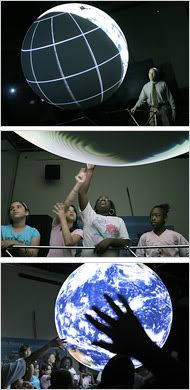You watch the distant Earth, turning slowly as the white puff that is Hurricane Katrina slides into the Gulf of Mexico. Then the sphere morphs into Mars; the largest volcano in the solar system, Olympus Mons, moves into view from a far horizon. Then it becomes Jupiter, with its swirling atmospheric bands and turbulent red spot.

The display is Science on a Sphere, a pioneering system for presenting planetary portraits gathered from satellites and other spacecraft. Essentially a spherical movie screen of white fiberglass, six feet in diameter, it displays video images from four computer-controlled projectors. Though stationary, it gives the illusion of spinning as the images move, and the nearly invisible wire that holds it up makes it seem to be floating in space.
"It's a unique way of showing planetary data sets that makes them come alive," said Michael Starobin, a senior producer for NASA Television working at the space agency's Goddard Space Flight Center here.
Researchers at the Earth System Research Laboratory of the National Oceanic and Atmospheric Administration in Boulder, Colo., developed the system several years ago as an educational tool for students and the public. But the system is becoming increasingly popular among scientists, who see it as a way of quickly conveying the gist of huge amounts of data.
"Everyone knew school kids would be impressed, but we've been surprised by the interest of scientists to get their data on the system," said Alexander E. MacDonald, the NOAA meteorologist who invented Science on a Sphere.
"We are visual animals," he went on. "If people visualize data, they tend to understand it, whether you are talking about 600 million years of continental drift or seeing an entire hurricane season projected in three minutes. This is a lot of information, but people get it if they can see it."
Science on a Sphere takes flat, two-dimensional images and data taken from spherical objects like planets and moons, and synchronizes and blends them into animated presentations. Most of the almost 100 presentations created so far are silent displays meant to illustrate lectures."




No comments:
Post a Comment